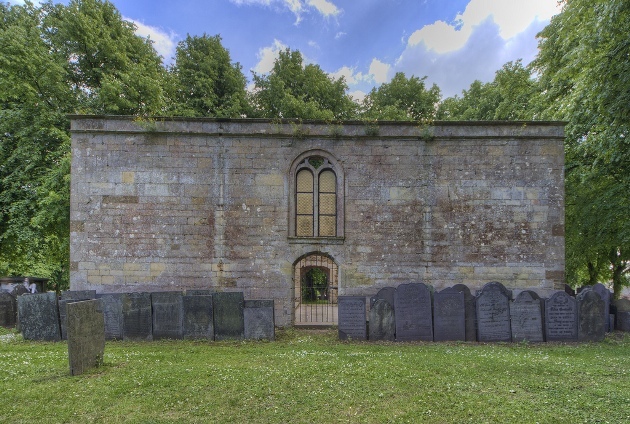
North view of the ruined church
The ruined church of St Mary in Arden is towards the east of the town centre just a couple of minutes drive away. There is not much to see now but this church was in fact the main church of the town but formerly was in the parish of Great Bowden. The church was first mentioned in 1220 when it had a resident chaplain which the chapel in Market Harborough (St Dionysius) was also dependent on. During the later Middle Ages there is no mention of clergy at St. Mary’s, which may have been served from Great Bowden or Harborough. After the appropriation of Great Bowden it evidently had a separate curate, as one is mentioned in 1574 and subsequently. In 1613 the cure of St. Mary’s was united with that of Harborough, partly at least because of scandalous conduct by the curates (no I do not have any more information!).
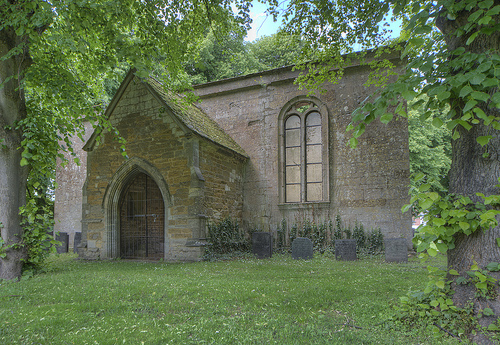
South view of church with the porch dating from the original church
The inhabitants had been buried at St Mary’s since the 15th century as St Dionysius had no churchyard. After 1614 burials continued although the church now became more of a mortuary chapel. The medieval church consisted of a nave, chancel, south aisle, porch and steeple. Only parts of the porch relate to the original building which would have led into the south aisle through the remaining 12th century Norman doorway. The church was in need of repair during the 16th century and the church was not well maintained after the union with Harborough. An earthquake in 1625 damaged the steeple and the church fell quickly into ruin and disuse. By 1662 the lead had been removed and in 1682 it was said the church had been ruinous for twenty years. There is also a report from Nicholls that the spire collapsed into the church around 1650.
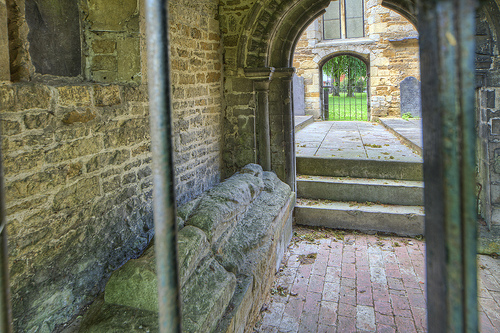
The 14th century porch, the 12th century doorway and the 15th century tomb
In 1692 it was decided to rebuild the church and 1694 the chapel was completed covering the previous south aisle. The rest of the church was removed at this time and carted away as ‘rubbish’ in 1694 although much of the stone was reused from the medieval church. The chapel was faced with limestone and comprised a rectangular room and south porch. There was also a north entrance and the roof was lead covered. By the end of the 18th century the building was again in a poor state, the floor was unpaved and glass was missing from the windows. In 1925 the chapel was repaired and refitted but after WWII the fittings were removed and in 1950 the lead from the roof was sold, by 1958 the building was roofless and derelict.
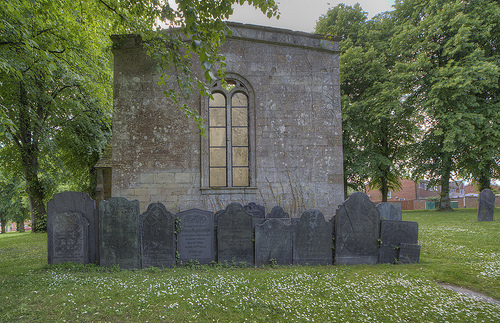
East end of church the headstones were removed in 1970 only a few remain
The chapel sits in a large churchyard but most of the remaining headstones are now around the remains of the building, there is a stone effigy (mutilated) in the south porch which originally would have been in the medieval church.
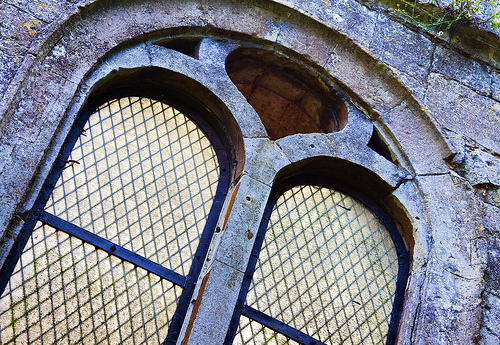
The 17th century windows in the chapel.
St Mary In Arden is sited on high ground, although with the modern buildings around the church this is hard to realize now. It would have overlooked Market Harborough originally but it fell into disuse due to St Dionysius being in the centre of the town. The ruins are locked although you walk around the outside and peer inside the open doorways. It is rather a sad place and it is hard to believe that the chapel could not have been saved in the 1950’s when it was finally made derelict. If you are in the area it is worth a visit to walk around the building.
david johnson
The cure of St Mary’s was united with that of St Dionysius in part because St Mary’s was the scene of many clandestine marriages.
Pam Abbott
A Service is still held here every Easter Saturday at 6.00pm, in accordance with the bequest of William Hubbard, whose gravestone is one of the few remaining in situ. In 1786 he left a rent-charge of one guinea to the church provided that ‘the Harborough singers’ sang the Easter hymn over his grave every year on Easter eve. The choir from St Dinnysius church has continued this unbroken tradition for (at the time of writing) the last 225 years.
Rosalind Willatts
The churyard was closed in 1878 and cleared 90 years later leaving only the most intereing 50 of the Swithland slate headstones all of them reset. Of particular interest is that to Samuel \Turner ( now on the north side) which he engraved himself with an account of his life. There are engravings of him as a shepherd at Harrington .He surveyed Market Harborough and made its first map c 1771. The Headstone incorporates a sundial, though the gnomen is lost.
![]()



April 6, 2016
I just had a quick look at your very interesting website and I can add a bit to the details of St Mary in Arden in Market Harborough.
Have you read “The story of England”, the book of the TV series of the same name?
This points out a little known aspect – namely that this little church was to the medieval people the equivalent of what Lourdes is to us today; i.e. one of the main places of pilgrimage in Europe. This was confirmed to me by more than one local resident when I made a visit to the ruins in February.
Although the church is small, the size does seem about right when one considers the size of the population in those days combined with the differences in pilgrimages between then and now. In those days, travel was difficult and would have been by foot or horse and there were no ferry services across the Channel. A pilgrimage then was a long “once off” journey yet with little time spent at the destination.
Today, of course, people go again and again and can complete the journey in a matter of hours – then they stay at the destination for a week and buy a mountain of souvenirs. That is not how it used to be at all; taking that into account the size does make sense in that respect.
The book mentions that in one small window there is the remains of a statue of Mary; although I cannot be sure I assume this is the boarded up window in the porch immediately above the 15th century tomb as it does show signs on the inside of once having had something fixed there which would have occupied much of the window space.
March 22, 2019
My ancestor Thomas Moore (father of John Moore, Bishop of Ely) was supposedly buried in an alter tomb at St.Mary in Arden in 1686. Are there any surviving records for this time? Thank You.
May 19, 2020
There is a saint tomb in the grounds
I think these maybe my ancestors
Does anyone have any information about these people
Thanks
February 1, 2021
Hello, I hope you don’t mind me replying, but I live near St Mary in Arden and recently wrote about the Saunt tomb
“This tomb belongs to the Barfoot-Saunt family and can be found in the abandoned churchyard of St Mary in Arden, Market Harborough
Although I was unable to find out a great deal about the family, it’s clear from the censuses, and the fact that they were able to afford such a stately tomb, that they were a financially comfortable family. The family patriarch, Lewis Saunt (a grazier by trade,) passed away sometime around 1841. In the census at the time, his widow Joanna (nee Barfoot,) and their 3 adult children, Jane, Thomas and Joanna are listed as living in Great Bowden with 4 servants
5 years later, Joanna would pass away. She died just a year before her youngest daughter’s marriage to Mottisfont-born Frederic Roberts. Joanna’s marriage would be the only marriage for any of the Saunt siblings, as neither Jane nor Thomas ever chose to marry
Thomas died in November 1876, 2 years before the death of his sister Jane, whose side of the tomb is shown above. Jane died on the 5th of January 1878, aged 78. She left £45,000 to Joanna and Frederic, £350 of which Joanna put in a trust to aid Great Bowden’s “aged, infirm poor, and cripples of the parish”
In November 1884, Joanna returned to Great Bowden to inter her husband, Frederic, in the family tomb under the name Frederic Barfoot-Saunt. He had died in the parish of Melbury Bubb, Dorset where he had been reverend for 24 years. Joanna herself would be the last to enter the tomb, dying on the 1st of May 1888, her 87th birthday”
I’ve attached the link to my post (https://www.instagram.com/p/CJ0oCAUlwHo/) as I also took a photo of the tomb
I hope any of the above helps 🙂
June 25, 2021
Hi thanks that’s very helpful, I’m from the saunt family from Lancashire but I know my family originally came from Leicestershire
I’ve visited the tomb once
But can’t seem to be able to gain a picture of the site
August 30, 2021
Hi Adrian
Is it a photo of the tomb you want? If so look at my instagram page @bridgeadaire I’ve posted some images from the church.
January 24, 2023
My 9th Great Grandparents, Mary Spence and John Stokes, were married at St Mary in Arden way back on the 17th September, 1734. It was a Friday and I like to imagine it was a lovely sunny early autumn’s day. Mary was just 16 and John was already a widower aged just 22. They both actually lived in Great Easton which is a good 8 miles away!
Strangely, my mother and brother both moved separately to Market Harborough many years ago, with at the time, no known family connections to the area. The ruins of St. Mary in Arden are less than a miles walk from my mums home and I am definitely going to visit it the next time i’m visiting her, ideally in mid September so I can properly pay homage to my recently discovered ancestors. I might take a small posy of flowers to St Marys to leave in memory of that young, happy couple.
October 27, 2023
this is very interesting.. I made a video https://youtu.be/GxmyL7coNE8?si=4_xDz-Eem8yKsZYz
I wish I had read all this before as I was guessing at the history and probably got quite a bit wrong